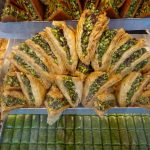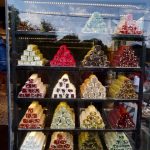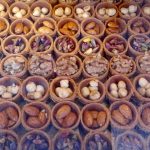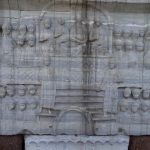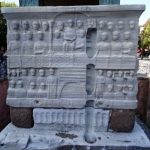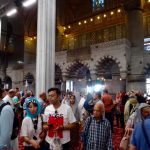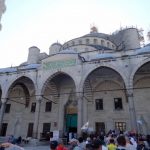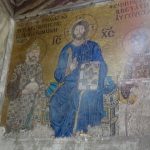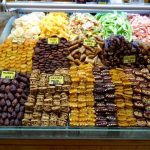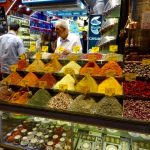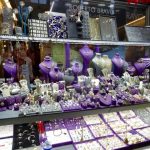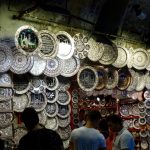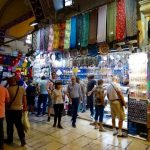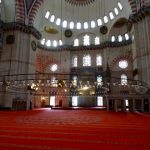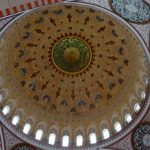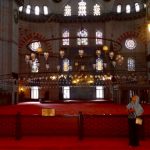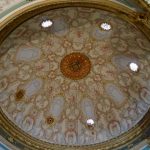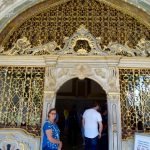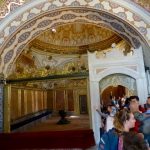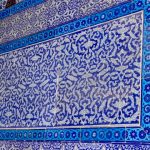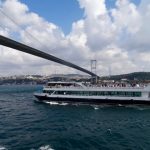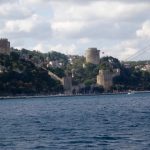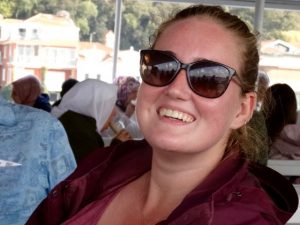 If, having flown in from Tbilisi, I might think that a weekend in Istanbul is a good way to relax and unwind after a trek, I couldn’t have been more wrong. We were met by our charming guide, Melissa, at the new Istanbul Airport to be escorted to the Budo Hotel in town. The journey took about an hour. During that time, Melissa fed us with information. There was something very northern about her accent, enough for me to question where she was from. With a Manchurian mother and Turkish father she has managed to inherit some northern twang in the odd word. Considering she has lived in Turkey since she was four, it is probably quite remarkable that it is still detectable. You know what they say, “You can take the girl out of Manchester but you can’t take Manchester out of the girl!”
If, having flown in from Tbilisi, I might think that a weekend in Istanbul is a good way to relax and unwind after a trek, I couldn’t have been more wrong. We were met by our charming guide, Melissa, at the new Istanbul Airport to be escorted to the Budo Hotel in town. The journey took about an hour. During that time, Melissa fed us with information. There was something very northern about her accent, enough for me to question where she was from. With a Manchurian mother and Turkish father she has managed to inherit some northern twang in the odd word. Considering she has lived in Turkey since she was four, it is probably quite remarkable that it is still detectable. You know what they say, “You can take the girl out of Manchester but you can’t take Manchester out of the girl!”
Driving in from the airport, which is some distance away, you soon realise what a sprawling city Istanbul is. With a population of just over 15 million it is by far the largest city in Europe and is double the population of London. It is vast! As we got further into the urbanised area, the traffic became more congested. It was Friday, after all, and all cities become congested as people prepare for the weekend. But it wasn’t just the roads that were congested, the pavements were full. There had been the call to prayers a little before we reached the city and worshippers were gathered kneeling on their prayer mats, wherever they could, adding to the congestion.
Our minibus got as close as it could to the Budo Hotel, but we had to walk the last 100m or so along a street that seemed to specialise in fabrics. Huge bundles of fabric were piled on the pavements waiting to be delivered elsewhere in the city. The shopkeepers and fabric workers sat on little pavement stools, drinking strong coffee and chatting while waiting for customers.
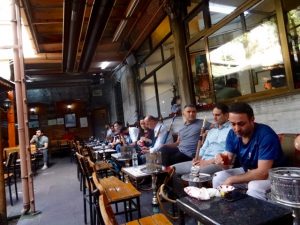 After a few minutes to settle ourselves in, Melissa walked with us towards the centre of town, the hub by the Bosporus where everything happens. Every so often, she would stop us in order to give us bits of information. One of those places was a Nargili cafe, where, predominantly men, go to smoke hookah pipes. We wandered in to find them all sitting in rows, smoking. Attendants helped keep them alight by refreshing the hot coals. There was a warm, aromatic fug hanging in the air. It was fascinating to watch and we were made to feel welcome by the smokers who were happy to show us their nargili pipes.
After a few minutes to settle ourselves in, Melissa walked with us towards the centre of town, the hub by the Bosporus where everything happens. Every so often, she would stop us in order to give us bits of information. One of those places was a Nargili cafe, where, predominantly men, go to smoke hookah pipes. We wandered in to find them all sitting in rows, smoking. Attendants helped keep them alight by refreshing the hot coals. There was a warm, aromatic fug hanging in the air. It was fascinating to watch and we were made to feel welcome by the smokers who were happy to show us their nargili pipes.
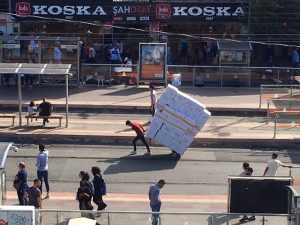 By now it was beyond three in the afternoon and we had not had lunch, so we found a pleasant rooftop restaurant where we could have a light meal and a beer or two, while looking down on to the busy street below. Istanbul is full of contrasts. Plying their way up and down the main street are modern trams, used extensively as a means to get around the city. Without them the traffic would simply be at a standstill. But, there, dragging a heavily laden trolly along the tramway, is a porter straining to pull his load of precariously piled boxes. Occasionally we would come across trollies stacked against a lamppost waiting for its next load to be laboriously dragged through the streets.
By now it was beyond three in the afternoon and we had not had lunch, so we found a pleasant rooftop restaurant where we could have a light meal and a beer or two, while looking down on to the busy street below. Istanbul is full of contrasts. Plying their way up and down the main street are modern trams, used extensively as a means to get around the city. Without them the traffic would simply be at a standstill. But, there, dragging a heavily laden trolly along the tramway, is a porter straining to pull his load of precariously piled boxes. Occasionally we would come across trollies stacked against a lamppost waiting for its next load to be laboriously dragged through the streets.
After our bite of lunch we continued further into town, the streets getting busier the further we walked. The shop displays were amazing, with Baclava delicately balanced in the window to catch the passing shopper’s eye. Colourful lighting shops with lamps made of stained glass, exotic rug shops and others selling colourful pottery. There was always something to feast your eye on.
We were also on the lookout for a restaurant to eat in in the evening, and having sorted one, I returned to the hotel to wait for the three who were flying out from England to join us, including Angela. We timed it just right, getting back minutes before they were delivered to the hotel.
Soon we were heading back out again to face the pedestrian gauntlet. Our restaurant required us to sit on low cushions, tucking our legs under a low table. Some found it easier than others and some soon found the position increasing uncomfortable. The food was good.
On the way back, Mike decided to buy himself an ice-cream from a colourful Gelato man. The ice-cream is very different from that we eat at home. It is called dondurma and is made from cream, whipped cream, salep, mastic and sugar. It doesn’t matter which stall you buy your ice-cream from they all have a ritual that entertains a crowd while the purchaser is ridiculed. The outcome is that more people subject themselves to the ridicule, increasing the vendors income. Having watched Mike go through the process, I had to have a go. It is great fun, and who cares about the ridicule?
With no chance for a lie-in, Melissa met us at 8.00 ready to start our tour of Istanbul. To save time we took the tram into the heart of the city and visited the Hippodrome, a large 100,000 seat open space that once was the scene of chariot races, circuses and many other entertainments. It was a good idea starting early as we had the place largely to ourselves to begin with. Not a lot remains of the original Hippodrome, but it has retained its shape and you can let imagination do the rest.
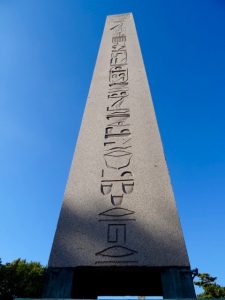 At one end there are two columns, the first being the Egyptian Obelisk. This is in almost perfect condition with hieroglyphics up all four sides. The most remarkable thing about this is the fact that it is a single piece of pink granite, 19m tall. Originally 30m high, it stood in the Temple of Egyptian Pharaoh Thutmosis III, built in the 15th Century BC. It was brought from Karnak to Constantinople in AD 390. Whether they reduced the height then for transport reasons or afterwards, I don’t know. Whatever the length, how did they transport such a heavy, cumbersome piece of stone all that way? Around its base may give some clue as to how. The obelisk sits on a plinth of limestone, into which is carved images of how it was moved. It was an incredible achievement of engineering, and, the stone looks so good and pristine, it could have been carved yesterday.
At one end there are two columns, the first being the Egyptian Obelisk. This is in almost perfect condition with hieroglyphics up all four sides. The most remarkable thing about this is the fact that it is a single piece of pink granite, 19m tall. Originally 30m high, it stood in the Temple of Egyptian Pharaoh Thutmosis III, built in the 15th Century BC. It was brought from Karnak to Constantinople in AD 390. Whether they reduced the height then for transport reasons or afterwards, I don’t know. Whatever the length, how did they transport such a heavy, cumbersome piece of stone all that way? Around its base may give some clue as to how. The obelisk sits on a plinth of limestone, into which is carved images of how it was moved. It was an incredible achievement of engineering, and, the stone looks so good and pristine, it could have been carved yesterday.
The second obelisk, just a few metres away is the Constantine Obelisk, at 32m is much higher but it is made out of stone blocks, nothing like as tough as the pink granite of the Egyptian Obelisk. It is also not as old.
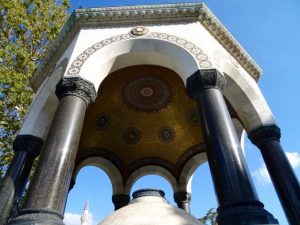 At the northern end of the Hippodrome is the German Fountain, gifted to the Turks in 1898 to commemorate the visit of the German Emperor, Wilhelm II. It is like a domed gazebo and the fountain is not a fountain in the normal sense but a series of taps and marble basins around the outside. Typical of German plumbing technology, the taps still work.
At the northern end of the Hippodrome is the German Fountain, gifted to the Turks in 1898 to commemorate the visit of the German Emperor, Wilhelm II. It is like a domed gazebo and the fountain is not a fountain in the normal sense but a series of taps and marble basins around the outside. Typical of German plumbing technology, the taps still work.
The crowds were definitely building up. Next we visited the Blue Mosque. This was a bit of a disappointment, not because it is not a splendid building, but because it is undergoing extensive renovations. This meant that none of the beautiful tiles of the dome were available to view, being hidden above a false ceiling held up with numerous disguised scaffold pillars . I am fortunate in that I have been before and seen the effect the blue tiles have on the light. None of that was possible. Despite the renovation works, it is still a remarkable building.
It was a similar story at Hagia Sophia, which is going through similar renovations. One section of it is a complex network of scaffolding reaching right up into the dome. Hagia Sophia started out as a church, built by Emperor Konstantios in AD 360. That was burnt down in a riot in AD 404 and a second church was built by Emperor Theodosius II in AD 415. It experienced a very turbulent time as a church, being destroyed or severely damaged on a number of other occasions.
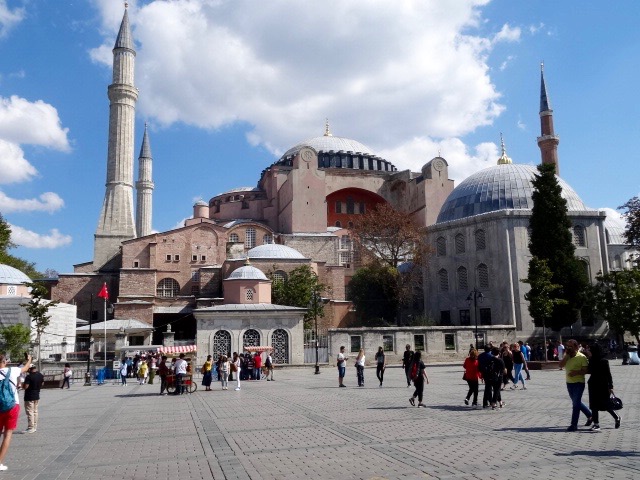 In 1453 Hagia Sophia was renovated into a mosque, marking the beginning of the Ottoman period and the change from Orthodox Christian to Islamic faith. Minarets were built and other islamic features.
In 1453 Hagia Sophia was renovated into a mosque, marking the beginning of the Ottoman period and the change from Orthodox Christian to Islamic faith. Minarets were built and other islamic features.
 It is now a museum. From the outside it looks like a hotchpot of extension after extension and much of the classic external features are lost. Inside, it is stunning. The sheer scale of the building is incredible. There is much to do to renovate the mosaics, something that will probably take many lifetimes to achieve. The lights that hang in huge chandeliers are fascinating. Each light is housed in an upturned glass globe with a nipple at the bottom end. Although they are electric lights now, each globe used to have a candle in it. The wax used to gather in the nipple, while soot coated the inside of the globe. They would extract both the wax and the soot, mix it together to produce a type of ink for use in writing.
It is now a museum. From the outside it looks like a hotchpot of extension after extension and much of the classic external features are lost. Inside, it is stunning. The sheer scale of the building is incredible. There is much to do to renovate the mosaics, something that will probably take many lifetimes to achieve. The lights that hang in huge chandeliers are fascinating. Each light is housed in an upturned glass globe with a nipple at the bottom end. Although they are electric lights now, each globe used to have a candle in it. The wax used to gather in the nipple, while soot coated the inside of the globe. They would extract both the wax and the soot, mix it together to produce a type of ink for use in writing.
The visits so far had taken all morning, so taking a break for some lunch at Mihri Restaurant adjacent to a hamami (bath house). The food was good, the atmosphere excellent as it gave us a little respite from the crowds. A harpist played, adding to the tranquility of the place.
 Back in amongst the crowds we next visited the Basilica Cistern, a vast, underground water supply for the old city. 170m long, 70m wide and with 336 supporting pillars, many of which were stolen from other temples,, the Basilica Cistern was built by Emperor Justinian in AD 532. It is an incredible, breathtaking piece of engineering. It was able to store 80,000 cubic metres of water fed by 20km of aqueducts.
Back in amongst the crowds we next visited the Basilica Cistern, a vast, underground water supply for the old city. 170m long, 70m wide and with 336 supporting pillars, many of which were stolen from other temples,, the Basilica Cistern was built by Emperor Justinian in AD 532. It is an incredible, breathtaking piece of engineering. It was able to store 80,000 cubic metres of water fed by 20km of aqueducts.
 Two of the columns are of particular interest and both involve Medusa. One has her head lying sideways at the base of the column while the other has her upside down at the base. There are numerous theories surrounding their position but the most likely is that the Byzantines had little regard for Roman relics and that it was a sign that the christian rulers wanted to get the message across that pagan figures play no part in christianity.
Two of the columns are of particular interest and both involve Medusa. One has her head lying sideways at the base of the column while the other has her upside down at the base. There are numerous theories surrounding their position but the most likely is that the Byzantines had little regard for Roman relics and that it was a sign that the christian rulers wanted to get the message across that pagan figures play no part in christianity.
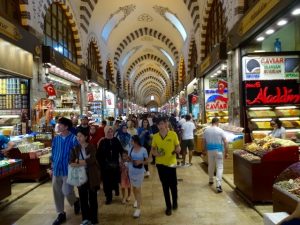 Next we faced the crowds as we walked down to the waterfront near the Galata Bridge, making sure that we did not get hit by a tram in the very narrow streets. We were making our way to the Egyptian Bazaar, or Spice Bazaar. This is a colourful, vibrant, noisy and very crowded indoor market that seems to specialise mostly in spices, dried fruits, confectionary and the occasional jewellery stall. This is a fabulous place to try things, to enjoy banter with the shopkeepers and to buy, whether you want it or not, it is just great fun.
Next we faced the crowds as we walked down to the waterfront near the Galata Bridge, making sure that we did not get hit by a tram in the very narrow streets. We were making our way to the Egyptian Bazaar, or Spice Bazaar. This is a colourful, vibrant, noisy and very crowded indoor market that seems to specialise mostly in spices, dried fruits, confectionary and the occasional jewellery stall. This is a fabulous place to try things, to enjoy banter with the shopkeepers and to buy, whether you want it or not, it is just great fun.
From there we moved on to the Grand Bazaar, an indoor complex of nearly 4,000 shops. Melissa gathered us at one of the entrances to give us some background information. It was difficult to concentrate on what she was saying because we had incurred the wrath of a security guard who thought we were blocking the way in. We weren’t, and Melissa was keen to stand her ground against his over zealous and aggressive behaviour. You could tell, by the looks on the faces of nearby Turkish men, that they were amused by the altercation, but also impressed by Melissa’s tenacity in not giving in.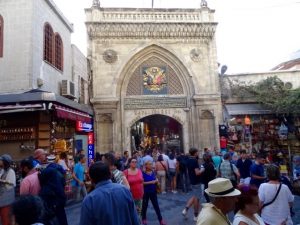
We suggested that we probably could manage the rest of the day on our own and that Melissa could go home for a well-earned rest. It was 5.00pm after all. At first, I think she might have felt put out, but we were all beginning to flag, and she must also after feeding us constantly with interesting information. I assured her it was no reflection on her but as this was the last venue on our itinerary for the day, we could manage.
Having satisfied her, we ventured past Mr Angry guard into the Grand Bazaar. It is a maze of passages, far too many to explore at this end of the day, so most of us remained on the main passageway, not going into shops, not engaging with the shopkeepers, most of whom seemed to be selling jewellery, and headed out of the opposite gateway, and back to the hotel via a visit to a bar for a well earned drink.
That night we ate in the Byzantion Bistro Restaurant, 150m from our hotel, that ensured we did not have to fight the crowds. It was highly acclaimed by Trip Advisor and did not disappoint. Excellent food and service.
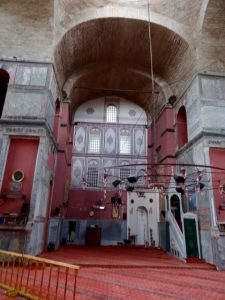 Another 8.00am start saw us walking through some back streets to Kalenderhane Mosque. Only cats, and there are many in Istanbul, prowled around outside the mosque. It seemed deserted and it took a while before somebody came to let us in. Starting out as a church, it was converted to a mosque at the beginning of the Ottoman period. because the church was not configured correctly for Islamic worship, the focus of worship is askew of the original with the prayer lines of the carpet on a diagonal. This is clearly visible in the photograph. This was a much small, quieter mosque. Running passed it outside was one of the old, Roman aqueducts that used to feed water to the Basilica Cistern.
Another 8.00am start saw us walking through some back streets to Kalenderhane Mosque. Only cats, and there are many in Istanbul, prowled around outside the mosque. It seemed deserted and it took a while before somebody came to let us in. Starting out as a church, it was converted to a mosque at the beginning of the Ottoman period. because the church was not configured correctly for Islamic worship, the focus of worship is askew of the original with the prayer lines of the carpet on a diagonal. This is clearly visible in the photograph. This was a much small, quieter mosque. Running passed it outside was one of the old, Roman aqueducts that used to feed water to the Basilica Cistern.
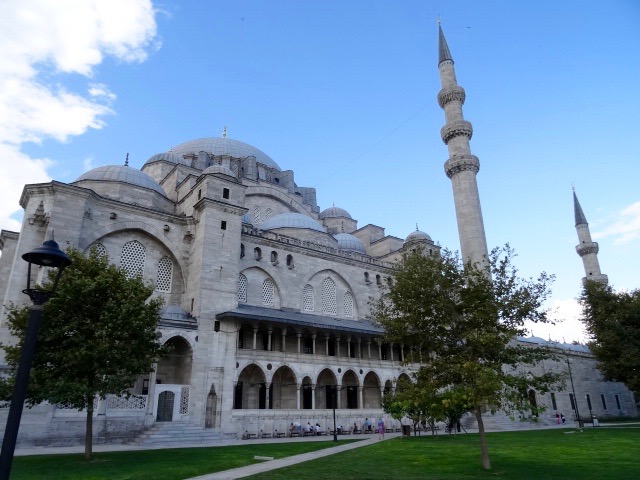 From there we headed to a much larger mosque, Suleymaniye Mosque. The mosque was commissioned by Suleyman the Magnificent and designed by the imperial architect Mimar Sinan. An inscription specifies the foundation date as 1550 and the inauguration date as 1557. How they could possibly build such a magnificent building in just seven years is incomprehensible. What is more, the quality of the stone work and the clean lines do not tally with its age. It looks almost new.
From there we headed to a much larger mosque, Suleymaniye Mosque. The mosque was commissioned by Suleyman the Magnificent and designed by the imperial architect Mimar Sinan. An inscription specifies the foundation date as 1550 and the inauguration date as 1557. How they could possibly build such a magnificent building in just seven years is incomprehensible. What is more, the quality of the stone work and the clean lines do not tally with its age. It looks almost new.
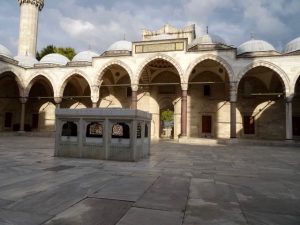 The other thing that impressed with this mosque is that we saw it in all its glory, without scaffolding and sections hidden behind workmen’s screens. To all intents and purposes this was a perfect mosque. Again, it was largely crowd free but the peace was interrupted by some young children who thought it was okay to charge around, chasing each other and shouting.
The other thing that impressed with this mosque is that we saw it in all its glory, without scaffolding and sections hidden behind workmen’s screens. To all intents and purposes this was a perfect mosque. Again, it was largely crowd free but the peace was interrupted by some young children who thought it was okay to charge around, chasing each other and shouting.
Here is an interesting fact: on the chandeliers, there are a number of white orbs. They are, in fact ostrich eggs. Why? Apparently, spiders don’t like ostrich eggs, so while they are in the mosque, spiders stay well clear.
Afterwards, we went to a rooftop cafe for coffee. Had we not had Melissa with us we would not have known it was there, but it afforded us fantastic views over the city, the Bosporus and beyond.
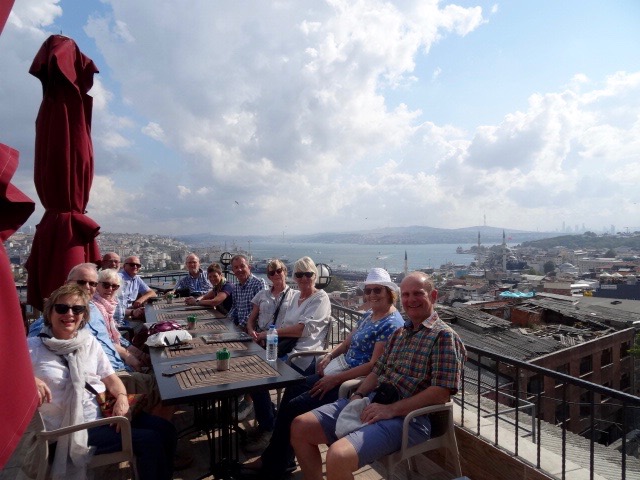 Next we headed to Topkapi Palace. This is where the sultans lived and administered over the Ottoman Empire. It is a complex set of palaces with a number of gates and courtyards, all leading to an inner court where the Sultan and his immediate family could relax, feeling the breeze coming off the Bosporus and looking out over their city.
Next we headed to Topkapi Palace. This is where the sultans lived and administered over the Ottoman Empire. It is a complex set of palaces with a number of gates and courtyards, all leading to an inner court where the Sultan and his immediate family could relax, feeling the breeze coming off the Bosporus and looking out over their city.
 The outer courtyard, the Court of the Janissaries, is where the security guards were stationed. These were made up of very loyal soldiers.
The outer courtyard, the Court of the Janissaries, is where the security guards were stationed. These were made up of very loyal soldiers.
Next came the Gate of Salvation that led into the second court where all the kitchens were and where meals were prepared for all 4,000 residents of the palace. Here, there was the Imperial Council Chamber, known as the Divan-i-Humayun because matters of court were discussed while lying on large divan beds. This is also where the harem was. It was while in this court we visited some of the Topkapi treasures with a display of weaponry and armour, all incredibly ornate.
The Third gate, The Gate of Felicity, led to the audience chamber, an area where the sultan would meet state visitors, although he would only meet them through a screen as he would not meet anybody below his equal face to face.
The Fourth Court was the inner court where the sultan could relax. Here there were pools of water to keep the air cool, ornately tiled rooms with large doorways to facilitate a flow of air. It was, by far, the most pleasant area of the whole palace, although the room where circumcisions took place was a little worrying.
Leaving the palace, we headed down to the Galata Bridge through the mayhem of tourists for a mackerel sandwich purchased from an ornate boat at the water’s edge. There were two men serving while others cooked in the background. Both of them had a huge wad of notes in their hand. They were working, and collecting money, non stop. It must be an absolute goldmine.
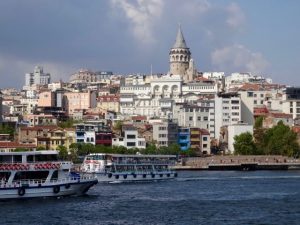 Afterwards we boarded our boat for a trip on the Bosporus, giving us a chance to sit, relax, take in the view and appreciate just where we were. Melissa did not switch off and gave us a running commentary throughout most of the trip. It was 90 minutes well spent.
Afterwards we boarded our boat for a trip on the Bosporus, giving us a chance to sit, relax, take in the view and appreciate just where we were. Melissa did not switch off and gave us a running commentary throughout most of the trip. It was 90 minutes well spent.
Back on shore we took the tram back to our hotel. We had exhausted Istanbul and Istanbul had exhausted us. Melissa was brilliant. I have done several trips to Istanbul but I feel I have learnt more, understood more about the history surrounding Istanbul, and enjoyed it more (despite it being both physically and mentally exhausting), than in all the other trips put together. Well done, Melissa.
That night we returned to the Byzantion Bistro Restaurant, because it was the easiest thing to do, and we knew it was good.
Thanks to Sobek travel for putting the trip together for us and a special thanks to Melissa.

